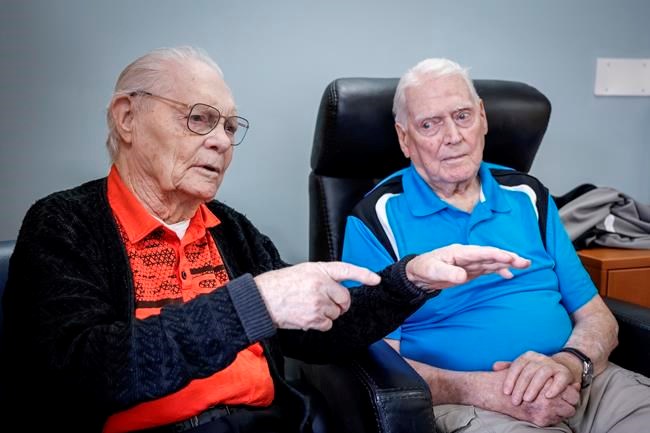CALGARY — The time around Remembrance Day is tough for Second World War veterans like Hank Jackson, who turns 103 in January.
"It's the only time you really stop and think about all the poor buggers that didn't make it," said Jackson, a former tail gunner on a Halifax bomber.
Jackson flew 32 combat missions from the United Kingdom. All members of his crew received Distinguished Flying Crosses from the United States Armed Forces.
"They've all disappeared. My father and my brother were both in the army overseas — my father in the First World War — and all three of us made it back. So we did above average. We gotta remember a lot of those guys that didn't."
Bill Cook, who is 98 and was also a tail gunner in the Second World War, flew a dozen missions over Europe.
"My crew have all passed away. It still haunts me."
More than one million Canadians served in the Second World War. More than 45,000 died and another 55,000 were wounded. Another 33,000 fought in the Korean War.
Veterans Affairs Canada says there are 9,267 veterans of the Second World War and Korean War who are still alive in Canada.
But as veterans die, military historians worry about keeping their history alive in the minds of Canadians.
Staff with The Military Museums in Calgary, home to eight separate museums, have interviewed many of the dwindling number of Second World War veterans.
"It's always a huge loss when we lose our veterans' voices," said senior curator Rory Cory.
"That's why it's important for us as a museum and as educators and historians in general to try and keep the public interest alive in those kind of things. It's up to the next generations to carry the torch forward."
Cory said the organization has come up with ways to get more war history into Calgary classrooms. There's a program called Explosive Threats related to mining and demining and peacekeeping. And there's another called Explosive Math, which has students do mathematical calculations to plot the shot fall of an artillery shell.
Karl Kjarsgaard, curator of the Bomber Command Museum of Canada in Nanton, Alta., said he's disappointed with how little students are learning in school about Canada's contribution to the Second World War.
"Why should children come to our museum and say, 'Canada was in World War II?' I am concerned that Canadians are not being told of the excellence of gentlemen like these guys that did their best to give us our freedom."
Canada’s involvement in the Second World War is taught in schools, but it often focuses on international conflicts and root causes as opposed to specific battles and exploits.
In British Columbia, for example, the provincial education ministry says social studies for Grade 10 covers the history of Canada and the world from 1914 to present day and requires all students learn about "international conflicts and co-operation," with the world wars a suggested topic.
Jackie Jansen van Doorn, executive director of The Military Museums Foundation, said stories from a source are key to educating the younger generation.
"Having someone who's actually been through a war and tell their first-hand experience is something that really makes memories for students that come through our doors," she said.
"The education component this is just huge, and having the loss of these veterans impacts on how the next generation remembers things."
Cook vividly remembered the first time he was in a firefight.
"The instructor would say, 'You don't shoot until you see the whites of their eyes.' This Focke-Wulf (German fighter plane) was coming in on the tail and I was sitting there waiting until he got closer, and all of a sudden he fired and hit the tail fin," Cook said.
"I was so bloody scared, I didn't know which way to turn. After that, I thought to hell with the hero worship. When a fighter came in and he was 400 or 500 yards away, I would fire a blast off to let him know, 'I see you,' and they would usually peel off."
Jackson said he doesn't remember a lot of the missions, but he does recall facing his own mortality.
"When we were flying, I honestly did not think we'd make it. Because, you know, I thought if it happened, it's going to happen, and I just hope it happens quick," he said with a laugh.
"I didn't want to go down in a flame or something."
Jackson said he has shared some of his experiences with young people who have come to visit, but he also understands why some aren't aware of what happened in the past. They may not have had family members who served.
"Anyone who has had a family member affected, they probably do."
This report by The Canadian Press was first published Nov. 10, 2023.
Bill Graveland, The Canadian Press




